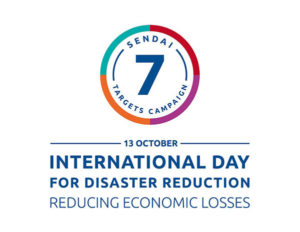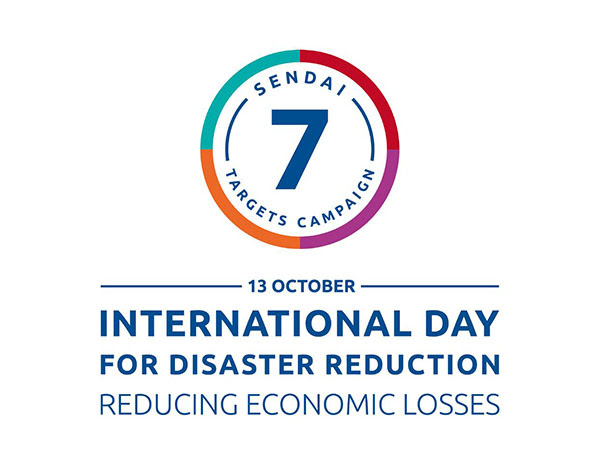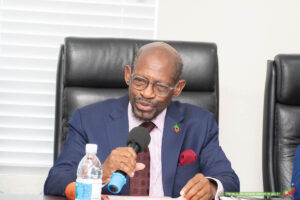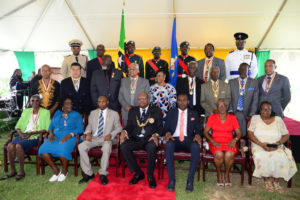Published 14 October 2018
Buckie Got It, St Kitts and Nevis News Source
|
GOVERNMENT OF ST. KITTS AND NEVIS TAKES DECISIVE ACTION TO MINIMIZE ECONOMIC LOSSES FROM NATURAL DISASTERS
Basseterre, St. Kitts, October 14, 2018 (SKNIS): With the frequency and ferocity of natural disasters globally and regionally due to climate change and its detrimental impacts, the Government of St. Kitts and Nevis is taking decisive action to mitigate against economic losses from disasters that can take a socio-economic toll on small island developing states with small economies of scale.
Some of these measures taken by the Federation include improving the road transport network, buttressing the healthcare system, building homes to be more resilient to natural disasters, and partnering with local, regional and international organizations in disaster mitigation including, the Caribbean Disaster Emergency Management Agency (CDEMA), the United Nations Office for Disaster Risk Reduction (UNISDR), the Austrian Development Agency (ADA), and the local disaster management agency, NEMA. With the passages of category 5 Hurricanes Irma and Maria during the 2017 Atlantic Hurricane Season, St. Kitts and Nevis suffered damages to homes (mainly roofs), infrastructure (including roads that were rendered impassable due to flooding and rockslides) and the agricultural sector. In an address on the occasion of the Local Observance of the International Day of Disaster Reduction on October 13, 2018, Permanent Secretary in the Ministry of National Security, Osmond Petty, outlined some initiatives that the country is taking to reduce economic losses from natural disasters. “As we join the global community in observing International Day for Disaster Reduction 2018, the Team Unity administration reiterates its commitment to working to ensure the reduction of economic losses in the face of disasters. We recognize that, in doing so, we will empower communities and families, protect lives and livelihoods, and give our children and their children stability, a sense of security and the very best future and country that they and all of us deserve,” said Mr. Petty. “In St. Kitts and Nevis, the human toll of displacement has seen our early childhood centres and secondary schools accommodate several students from other hurricane impacted islands, free of charge. These students came here to live with extended family and family friends in the aftermath of Hurricanes Irma and Maria, so that they can continue their education and personal development,” he said, adding that “the administration has extended support of $2.5 million EC dollars in cash and has also given in kind, to aid our neighbouring islands in their hurricane recovery efforts, which will cost in the billions of dollars.” Mr. Petty said that the damage suffered by neighbouring islands from Hurricanes Irma and Maria amounted to 3.5 times those countries gross domestic product (GDP). He also said that the Caribbean Tourism Organization reported that 1 billion dollars in tourism revenue was lost in the Caribbean. Bearing all this in mind, the Government of St. Kitts and Nevis set up a Hurricane Rehabilitation Committee to implement the Government’s Post Hurricane Relief Programme, which have seen thus far almost 1500 households benefiting from roof repair. Additionally, the Government is building homes that are more resilient with roofs made of galvalume under its Housing Solutions Programme. Also, the Government is presently involved in an EC$ 23 Million Road Rehabilitation Project to make the island’s road network less prone to disaster related impacts. Some of these include a proper draining system to reduce incidences of flooding; raised road elevation to address rising sea levels and strong waves; and retention walls to diminish land and rockslides. Furthermore, the Government is bringing healthcare closer to communities so that in emergencies created by disasters persons wouldn’t have to travel long distances. “For sure, our healthcare system has gotten a lot stronger through our robust investment targeted at disaster risk reduction (DRR). For instance, for the first time in many years, the Mary Charles Hospital and the patients it serves have their own EMT/ambulance service. With the addition of this 24-hour dispatch point, my Government has brought an ambulance closer to the people of the Keys to Saddlers Medical District, meaning that medical assistance is no longer dangerously distant. The Ministry of Health is also providing its EMT personnel with relevant and updated ongoing in-house training, as well as other continuing educational opportunities,” Mr. Petty said. “In essence, the Team Unity Government is ensuring Resilience for All, which is the theme for the local observance of the International Day for Disaster Reduction here in St. Kitts and Nevis,” Permanent Secretary Petty said. The International Day for Disaster Reduction 2018 is commemorated under the theme The SDGs and Disaster Risk Reduction: Meeting Target C of the Sendai Framework (Reducing the economic loss of disasters). The United Nations General Assembly has designated 13 October as the International Day for Disaster Reduction (IDDR) in order to promote a global culture of disaster reduction, including disaster prevention, mitigation, and preparedness. 2018 marks the third year of the Sendai Seven Campaign, which uses the IDDR to draw attention to the seven targets of the Sendai Framework for Disaster Risk Reduction 2015-2030, which was adopted as a global plan to reduce disaster losses. The overall IDDR theme for this year is reduction of economic loss resulting from disasters (Target (c) of the Sendai  |






